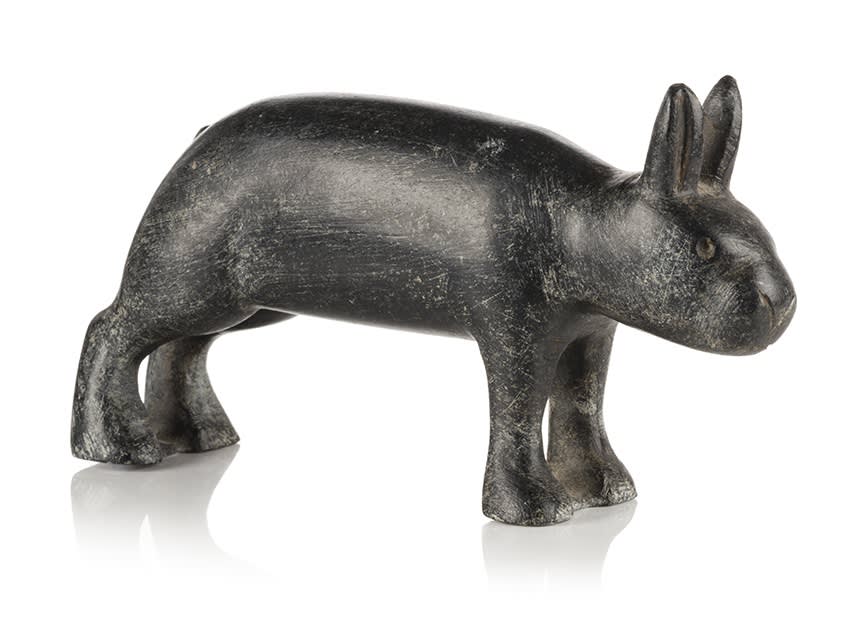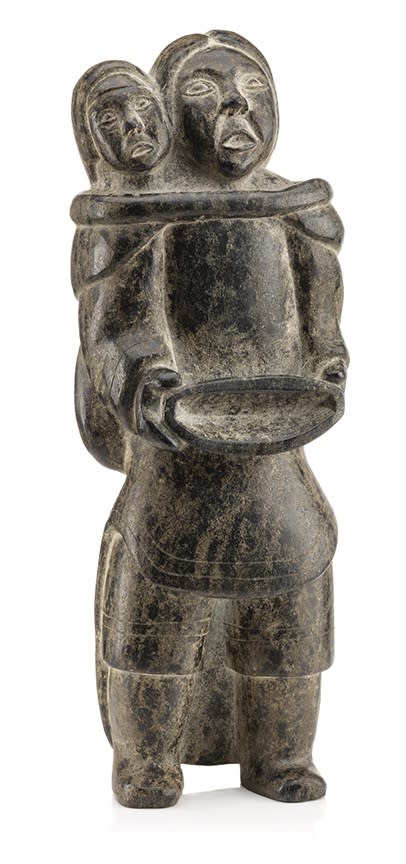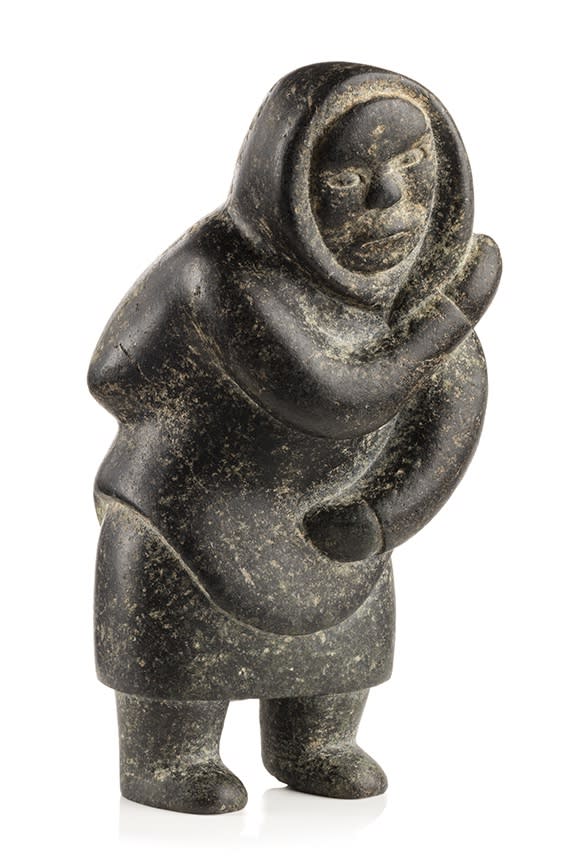The inaugural exhibition of Inuit art at the Canadian Guild of Crafts in 1949 was a smashing success. The featured works in that show were predominantly from Inukjuak (then called Port Harrison) in Nunavik (Arctic Québec). In October 1950 the Guild applied for, and received, a $9,000.00 grant to cover the travelling expenses of James Houston and his new wife Alma for an extending trip across Baffin Island. In January of 1951 James and Alma flew to Iqaluit (then Frobisher Bay) where they stayed for a month before setting off on dogsled to Kimmirut (Lake Harbour) and then Kinngait (Cape Dorset).
Houston said “(Cape Dorset) was quite different from either the east or west coast of Hudson Bay. I am still not sure why that was—perhaps because word of our attempted encouragement of Eskimo art had gone before us. I found the Inuit trading into Cape Dorset to be the most exciting, friendly, volatile, and certainly the most talented Inuit group that I had ever met. The Dorset people began right away to bring in carvings and seemed delighted with their payment slips that gave them instant trading power at the Hudson’s Bay Company.” (Darlene Wight, Early Masters, WAG, 2006, p. 135.)
A total of $2,300 was spent on “handicrafts” in Cape Dorset which was more than during Houston’s first year in Inukjuak. The new carvings from Kinngait garnered international attention with the National Gallery of Canada’s exhibition Eskimo Art which opened in January of 1952. In an exhibition of sixty-nine artworks, Kinngait artists presented the lion’s share with forty-five sculptures.
It is easy to see why the sculpture from Kinngait was so popular. One senses that the carvers from Cape Dorset literally “hit the ground running.” Even the very earliest of Kinngait sculptures display not only technical proficiency but an elegance of line which is truly remarkable. The most common subjects in the 1950s were depictions of Arctic fauna and depictions of people which were lifelike almost to the point of portraiture. Sculptures representing shamanism and the spirit world were less common until the early 1960s (see Pudlo Pudlat’s Sedna, c. 1961, Lot 51). We are most fortunate to have numerous excellent examples of early-mid 1950s Kinngait sculpture in our upcoming Fall 2023 sale.
Many of the earliest Kinngait sculptures were unsigned and, as a result, attributions are rather difficult since there were so many talented artists at work from day one. The Hunter with Knife (Lot 79) and Hare (Lot 109) are exceptionally elegant but lack the telltale flourishes which might allow us to give proper acknowledgement to their makers. On the other hand, Seated Dog (Lot 110) makes us wonder if the lovely carving might possibly have been made by the great Sheokjuk Oqutaq.
Fortunately, however there were also several artists whose works are instantly recognizable be they signed or not. We need look no further than at Qaqaq Ashoona’s magnificent Standing Mother and Child Holding a Qulliq (Lot 108) to prove the point. The animated facial features of both mother and child confirm Qaqaq as the maker, as do the sculpture’s perfect proportions and graceful curves. The attention to detail in the garments further attests to the brilliance of the artist.
Another artist whose authorship is evident is the great Niviaqsi (formerly known as Niviaksiak) and we are blessed to have three examples in the sale. There are two wonderful figural works from the early-mid 1950s Lots 9 and 78), both carved from the hard grey-black local stone, and a delightful bear from later in the decade carved from the recently discovered local serpentine (Lot 1). The superior quality of his works in sculpture as well as his spectacular contributions to the 1959 Cape Dorset graphics collection make his untimely death in 1959 even more tragic.
While most Kinngait carvings from the 1950s were of rather modest size, due in equal parts to the difficulty in quarrying and carving hard stone, there are always some exceptions that prove the rule. Peter Pitseolak’s striking Bust of a Mother and Child (Lot 50) is truly monumental for the period. Likely a portrait of his wife and child, the sculpture is large in scale yet sensitively rendered, making this a most impressive work indeed.
The 1950s in Kinngait was a highly significant period in establishing a community aesthetic that would only continue to flourish throughout the 1960s and 1970s, producing many of the finest masterpieces not only from the Canadian Arctic but from the country as a whole.
WORKS:

Lot 79
UNIDENTIFIED ARTIST, KINNGAIT (CAPE DORSET)
Hunter with Knife, c. 1955
ESTIMATE: $1,500 — $2,500
Carved from the hard grey-black stone found near Kinngait before the discovery of the local serpentine deposit, this excellent standing figure is the product of a gifted hand. While there are not enough telltale signs to help identify the artist, the astonishing fact is that by the mid 1950s there were already numerous talented artists at work in Cape Dorset. Despite his rather static pose, the subject’s parka, trousers, and kamiks are all sensitively carved with wonderful proportions. (Interestingly, while this stone was clearly quite difficult to carve, its texture actually lends a depth and richness to the sculptural forms.) Even the Bowie knife clasped in the hunter’s hand is finely detailed. Truly remarkable considering how relatively new art making still was in the region.

Lot 109
UNIDENTIFIED ARTIST, KINNGAIT (CAPE DORSET)
Hare, early 1950s
ESTIMATE: $1,200 — $1,800
The early 1950s was a period of great experimentation as more and more Inuit tried their hands at stone carving, using skills already in place from fabricating various tools and implements. As a hunting culture, the Inuit had intimate knowledge of Arctic creatures great and small. Initially working on a smaller scale, early carvers produced a tremendous variety of animalia. It was not uncommon to see sculptures of Arctic hares, dogs, siksiit (ground squirrels), otters, and other smaller animals before market forces made it more lucrative to produce seals, walrus, and especially polar bears. The identity of the carver of this delightful Arctic hare is lost to time but it is obviously the work of a practiced hand. While diminutive in size the piece exudes confidence, and the subject seems to be simultaneously vigilant and whimsical.

Lot 110
UNIDENTIFIED ARTIST, KINNGAIT (CAPE DORSET)
Seated Dog, early 1050s
ESTIMATE: $1,200 — $1,800
Like the previous lot, this naturalistically carved, palm-sized jewel is the work of an unidentified hand, although we think it is carved finely enough to consider Sheokjuk Oqutaq as a possible maker. It is somewhat ironic that even though each Inuit camp of the day had a bevy of canines, the solitary dog is a somewhat rare subject in Inuit art. Dogs were routinely featured as parts of larger compositions such as hunting or sledding scenes yet despite their importance in Inuit camp life, they are seemingly given short shrift in artistic representation. One wonders whether as “beasts of burden” dogs were not accorded the same importance as other Arctic fauna despite their symbiotic relationship with their masters. Regardless, this handsome specimen patiently awaits his owner!

Lot 108
QAQAQ (KAKA) ASHOONA (1928-1996), KINNGAIT (CAPE DORSET)
Stansing Mother and Child, Holding a Qulliq, c. 1955
ESTIMATE: $7,000 — $10,000
In our opinion Qaqaq Ashoona stands at the pinnacle of Cape Dorset sculpture from the mid 1950s, alongside the great Niviaqsi and Sheokjuk Oqutaq. Son of the beloved graphic artist Pitseolak and brother to the gifted sculptor Kiugak, Qaqaq carved distinctive and impressive works for the next forty years, but it is early sculptures such as this masterpiece that really inspire our admiration. The elegance and sensitivity of this Standing Mother and Child is quite remarkable, especially given that it was carved from an incredibly dense, heavy, and quite thin slab of rock. The figure’s simple standing pose might be static were it not for its beautiful proportions and graceful curves, the lovely and expressive faces of both mother and child, the charming flip of the mother’s left shoulder, and the subtle tilt of the child’s head. We also love the way the woman holds the qulliq, an iconic symbol of warmth and light. We wonder if it’s a gift or a treasured heirloom. Simply gorgeous.

Lot 9
NIVIAQSI (NIVIAKSIAK) (1908-1959), KINNGAIT (CAPE DORSET)
Standing Woman, c. 1953
ESTIMATE: $10,000 — $15,000
In our December 2022 live auction (Lot 26) we featured a stunning Mother with a Child on Her Shoulders by the artist, which we dated to c. 1955. We are of the opinion that this lovely Standing Woman probably dates to a couple of years earlier (c. 1953) and reveals a somewhat more experimental Niviaqsi. Whereas the 1955 sculpture was sensuously voluminous, this lady is far more svelte yet not inelegantly so. While clearly Niviaqsi was still finding his way stylistically, this impressively large early masterpiece already reveals the artist’s command of refined sculptural form and delicately rendered detail. The charmingly small arms and feet only serve to accentuate the figure’s imposing sculptural presence. Despite the impressive monumentality of the work, it possesses an almost graphic sensibility that we have admired in other sculptures by the artist; this is perhaps why Houston enlisted Niviaqsi as one of his first print artists later in the decade. Standing Woman is a formidable example from the earliest period of Cape Dorset sculpture and is lovely to boot.

Lot 78
ATTRIBUTED TO NIVIAQSI (NIVIAKSIAK) (1908-1959), KINNGAIT (CAPE DORSET)
Woman Adjusting her Hood, c. 1954-55
ESTIMATE: $3,000 — $5,000
A search for the essence of the subject, rather than the replication of details, is evident in this wonderful standing figure. Depicting a young woman leaning forward to rebalance the weight of the child asleep in the rear pouch of her amautiq, the brilliantly talented Cape Dorset sculptor Niviaqsi has manifested the feelings of the figure through understated, almost geometrically pure forms. The glow of the textured yet smoothly finished surface, along with the gentle contours of the softly articulated masses, contribute to a feeling of serenity that permeates the work.
